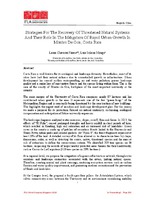Mostrar el registro sencillo del ítem
Strategies for the recovery of threatened natural systems and their role in the mitigation of rapid urban growth in Montes de Oca, Costa Rica
| dc.contributor.author | Chaverri-Flores, Laura | |
| dc.contributor.author | Solano-Monge, Luis | |
| dc.date.accessioned | 2018-10-23T19:50:06Z | |
| dc.date.available | 2018-10-23T19:50:06Z | |
| dc.date.issued | 2018 | |
| dc.identifier.citation | Chaverri-Flores, L., & Solano-Monge, L. (2018). Strategies for the recovery of threatened natural systems and their role in the mitigation of rapid urban growth in Montes de Oca, Costa Rica. Congreso Mundial IFLA, Singapur 2018. | es |
| dc.identifier.uri | https://hdl.handle.net/2238/10031 | |
| dc.description | Conferencia | es |
| dc.description.abstract | Costa Rica is well known for its ecological and landscape diversity. Nevertheless, most of its cities have lost their natural richness due to uncontrolled growth in infrastructure. Urban development has caused surface waterproofing, air and water pollution, poorer landscape quality and a major loss of most native forests and the species living within them. This is the case of the county of Montes de Oca, birthplace of the most important university in the country. The main campus of the University of Costa Rica comprises nearly 87 hectares and has conditioned urban growth in the area. It represents one of the few “green lungs” of the Metropolitan Region and is constantly being threatened by the construction of new buildings. This highlights the urgent need of an urban and landscape development plan. For this reason we made a proposal for its protection, focused on natural continuity, cushioning, ecological compensation and anticipation of future university expansion. The landscape diagnosis analyzed water resources, slopes, runoff, flora and fauna. In 2017, the effects of “El Niño”, caused prolonged droughts and heavy rainfall in short periods of time, which resulted in flooding, high soil saturation and an increased risk of landslides. Green cover in the county is made up of patches of secondary forests linked to the University and Torres River, urban parks and isolated gardens. At “Finca 3”, the forest fragments represent at least 26% of the land. A detailed survey of its flora allowed us to characterize trees by shape, dimensions, color, as well as detecting the scarce, native, threatened species and the ones at risk of extinction to define the conservation criteria. We identified 209 tree species on 34 hectares, surpassing the records of larger nearby protected areas famous for their biodiversity, such as Cerros de La Carpintera (110 tree species in 2391 hectares). At a regional level, we propose the integration of a green infrastructure network, through river corridors and landscape connectors associated with the rivers, linking natural spaces. Therefore, creating animal and plant crossings, nurturing ecosystem services such as carbon fixation and water quality improvement, and promoting outdoor recreation and the prevention of floods and landslides. At the Campus level, the proposal is built upon four pillars: the Articulation System, which solves connectivity issues between the University and its environment considering mobility factors; the Border System, which analyzes the relationship with the context, adding defined accesses and cushioning fringes; the Functional Units System, which groups homogeneous elements with defined identities; and finally, the Conservation and Ecology System, which promotes ecological and landscape connectivity through two components: water and vegetation. Green infrastructure acts as a natural public health system, favoring physical activity, establishing a bridge that unites forest patches and boosts ecosystem services responsible for preventing climate change. In order to mitigate flooding, there is a chain of lagoons in which water moves by gravity, accompanied by canals and rain gardens that delay water speed, improve its quality and enriches the user experience. | es |
| dc.description.sponsorship | IFLA World Congress Singapore 2018; International Federation of Landscape Architects (IFLA); Universidad de Costa Rica; Instituto Tecnológico de Costa Rica | es |
| dc.language.iso | eng | es |
| dc.publisher | IFLA World Congress Singapore | es |
| dc.rights | Attribution-NonCommercial-ShareAlike 4.0 International | * |
| dc.rights.uri | https://creativecommons.org/licenses/by-nc-sa/4.0/ | * |
| dc.subject | Urbanismo | es |
| dc.subject | Paisajismo | es |
| dc.subject | Infraestructura | es |
| dc.subject | Pérdidas -- Biodiversidad | es |
| dc.subject | Inundación | es |
| dc.subject | Recuperación -- Sistemas | es |
| dc.subject | Mitigación | es |
| dc.subject | Urbanism | |
| dc.subject | Landscaping | |
| dc.subject | Infrastructure | |
| dc.subject | Losses -- Biodiversity | |
| dc.subject | Flood | |
| dc.subject | Recovery -- Systems | |
| dc.subject | Mitigation | |
| dc.title | Strategies for the recovery of threatened natural systems and their role in the mitigation of rapid urban growth in Montes de Oca, Costa Rica | es |
| dc.type | info:eu-repo/semantics/conferenceObject | es |
Ficheros en el ítem
Este ítem aparece en la(s) siguiente(s) colección(ones)
-
Investigación [9]



